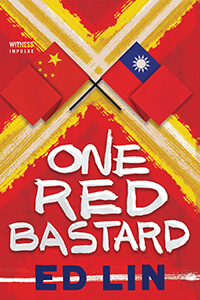on Tour November 20 – December 31, 2017
 One Red Bastard
One Red Bastard
by Ed Lin
Genre: Mystery
Published by: Witness Impulse
Publication Date: November 21st 2017
Number of Pages:
ISBN: 0062444204 (ISBN13: 9780062444202)
Series: Detective Robert Chow #3
Purchase Links: Amazon ? | Barnes & Noble ? | Goodreads ?
It’s the fall of 1976, and New York’s Chinatown is in turmoil over news that Mao’s daughter is seeking asylum in the U.S. Robert Chow is a detective in training, and he is thrilled when his girlfriend Lonnie scores an interview with the Chinese representative of Mao’s daughter. But hours after the interview, the man is found dead. Lonnie, the last person to see him alive, is the main suspect.
As Lonnie is subjected to increasing amounts of intimidation from his fellow policemen, who want to close the case, Robert is tempted to reach into his own bag of dirty tricks. Will he stay on the right side of the law, or will his loyalty to Lonnie get the better of him? Find out in this exciting and fast-paced mystery set in one of New York’s most fascinating neighborhoods.
Five Interesting Facts About Chinatown
Buildings don’t have fourth floors. But so many of them are way more than four stories high–what’s the deal? The word “four” sounds like “death” in many Chinese dialects (I’m also told that this is true in Korean and Japanese). Chinese are super superstitious, so they avoid things that even sound like bad outcomes. So they just deep six the four. Diligent building managers also eliminate the 13th floor, as well–just to cover all the bases.
Banks are open seven days a week. The concept of banking and loans is older in China than the wide consumption of noodles, which apparently happened during the Han Dynasty, 200 years before the common era. Chinese people work all sorts of jobs at all hours and despite the advances in automatic teller machines, many prefer a live teller to deposit their cash with. Every bank in Chinatown wants to grow their deposits, even branches of major institutions: Chase and Citibank outlets in Chinatown are also open every day.
The legends of the three knives live on. It has been said that emigrants from China spread out all over the world based on their skills in three trades: cutting hair; tailoring clothes; and cooking food. Those occupations are the so-called three knives. The best barbers (for Asian hair) and clothes makers surely are in Chinatown. Best food? Well…it’s definitely up there.
Echoes of the Tang Dynasty continue. Cantonese people, Chinese from the southern part of the country, established and populated Manhattan’s Chinatown. But apparently, the Cantonese have their origins in the middle of the country. One term that they call themselves is “people of the Tang Dynasty.” The Tang’s capital was Chang’an, which is now known as Xi’an. In the chaos of the end of the Tang in 907 after the common era, the ancestors of Cantonese people fled south but preserved the spoken language. Poems from the Tang–among China’s most beloved–make more sense rhythmically when pronounced in Cantonese, not Mandarin, the official dialect.
Chinatown was built by associations. Chinese people are accused of being clannish and shunning outsiders, and that’s true to a certain degree. But overall, we keep casual friends at arm’s length while welcoming in complete strangers who happen to share the same family name or have origins in the same part of China or other diasporic gathering point in the world. There are more member associations in Chinatown than houses of worship. These groups, which were known as “tongs” in the early days before the term was viewed negatively, handled many social services before Chinese were eligible for naturalization and citizenship in the United States, which wasn’t until 1943. (http://www.uscis.gov/history-and-genealogy/history-and-genealogy-news/edward-bing-kan-first-chinese-american-naturalized-after-repeal-chinese-exclusion)
The associations invested in properties, and settled legal and other disputes both among members and other groups. They also took care of older members through the end and beyond, shipping bodies back to China for burial. Oddly, many of these associations find themselves much richer than they had ever imagined themselves to be as the value of real estate in Chinatown has soared. It’s a good thing the banks are open seven days a week.


1 comment
WOW! This was such an interesting post!